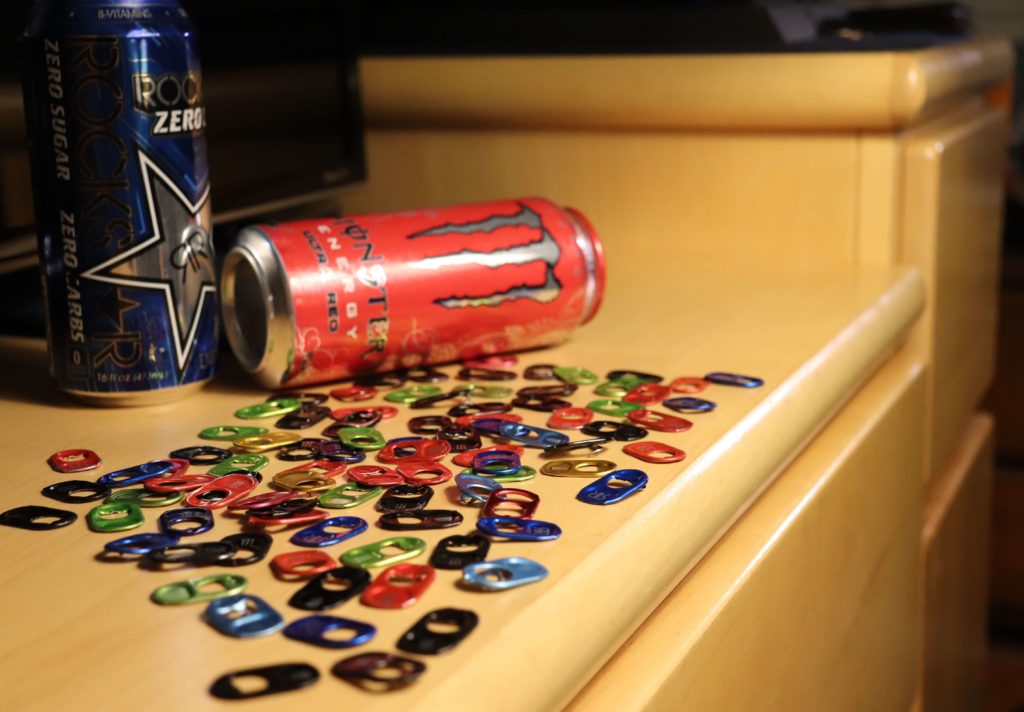“You’re gonna die by Senior year.”
“Do you even know what’s in those things?”
“…Can I have one?”
These endless words of criticism and craving would rattle within my head and echo throughout the art hallway in my Freshman year. However, my addiction wasn’t to any sort of illegal substance; instead, I would soon become an abuser of Monster Energy. As I’d lie there in the mornings, endlessly more tired than the last day, I’d inevitably pull out my daily energy drink can, rip off the tab, and drag myself from class to class. Yes, I took off the tab. After all, I collected them.
The evidence.
Ultimately, as my sleep schedule leveled out and my cash drawer was drained, I would learn to slightly cut down on my consumption, with my gas station hauls growing fewer and farther in between.
Yet, even nowadays, I still find myself chugging down the occasional Monster Ultra Violet, Rockstar Revolt Killer Citrus, or any other carbonated flavors with flamboyant names, and still find myself under a swarm of criticism from my peers. Such stigma felt by the Woodland community led me to extensively research the subject and determine the truth behind my energy addiction.
Few widespread commercial products remain quite as controversial as energy drinks. The industry consists of a vast spectrum of flavors, colors, cans, and companies, each with their own branding to plaster around. Companies such as Red Bull, Monster, Rockstar, and NOS have pervaded American culture with their slogans and logos. Yet, there still remains a public stigma on the nature of these companies. Local stories of energy drink-related injury or death illicit nationwide coverage, going so far as to gain the attention of governments worldwide. In fact, other countries, such as the United Kingdom, have already proposed an age limit on the sale of these drinks between sixteen and eighteen years old.
“It’s a scandal that certain energy drinks are being sold to children and teenagers under-16 ‘cheaper than water and pop’,” vents Kawther Hashem, Public Health Nutritionist and a researcher for CASH (Consensus Action on Salt and Health) and its international arm, WASH (World Action on Salt and Health). Many government authorities have sympathized with her call to action, condemning the brands for unapologetically abusing the impressionable youth into its trendy marketing.
With the average student having to juggle good grades, manage a decent social life, and maintain a healthy sleep schedule, most opt to only balance the former two. Thus, it’s only natural for some to rely on external sources for energy to power through the day. Energy drinks provide this in spades, with the average can of` Monster containing 142 milligrams of caffeine, 2,000 milligrams of taurine, and 400 milligrams of panax ginseng; all sources of energy to pump up the body- often in dangerous, unnatural ways.
“There’s a lot of chemicals that our bodies don’t know what to really do with,” says Vicki Delucia, Woodland’s resident school nurse. “They’re high in caffeine, which, especially teens don’t really need; there’s a ton of sugar, which leads to obesity.”
Clearly, not many medical professionals have given glowing endorsements on the beverages; however, these brands have recently led initiatives to shed this sugary stigma. Using Monster as an example, the company has diversified into branches such as Monster Rehab (an iced tea and lemonade spinoff), Java Monster/Caffé Monster (two branches of coffee [which is generally thought of as a safer source of energy]), and Monster Hydro (a far more sporty drink the vain of beverages such as Gatorade). In addition, most of the normal Monster flavors, particularly the Ultra series, now boast zero sugars and zero calories.
The replacement for this sugar, aspartame, may in fact be more hurtful than the alternative.
“Synthetic sugar, like aspartame has been proven to show cancer; it’s a cancer-causing agent, like Sweet N’ Low,” says Delucia. In fact, because of the sweeter taste of these unnatural sugar replacements, the body may become “even more addicted”, and in turn, crave other sugary substances from different sources.
So, is the solution to keep these drinks out of reach for teenagers, as is the case with other countries? Delucia advises against it.
“I think if they start regulating energy drinks, where do you stop? It’s teaching, it’s education, it’s life skills… you need those things.”
While my heart may still belong to Monster Energy, it’s important to acknowledge and understand the dangers of such a product. A ‘safe’ daily intake for one person may prove life-threatening to another with less weight and weaker body.
In essence, the focus of government and organizations such as CASH/WASH should not be simply to ban these drinks outright, or restrict them from the young, but rather guide and inform the masses on the dangers and chemicals that compose them.
Works Cited
“Academics and Campaigners Call for Age Limit on Energy Drinks.” New Food Magazine, www.newfoodmagazine.com/news/46973/age-limit-energy-drinks/.
“Government Consults on Energy Drink Age Limit.” Forecourt Trader, forecourttrader.co.uk/news/fullstory.php/aid/15553/Government_consults_on_energy_drink_age_limit.html.
“Kawther Hashem | Kawther Hasham08.” Zenfolio | Duncan Phillips Photography, duncanphillipsphotography.zenfolio.com/p731554266/h7CA9FFF7#h7dcc7ccb.
“Wolfson Institute of Preventive Medicine.” Queen Mary University of London, www.qmul.ac.uk/wolfson/about-us/staff/profiles/hasemkawther.html.





















